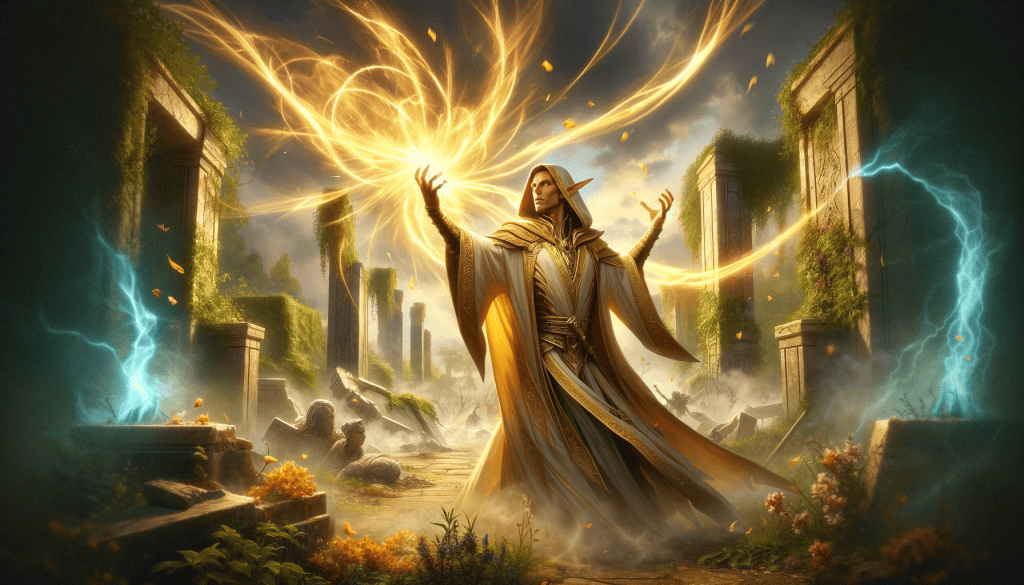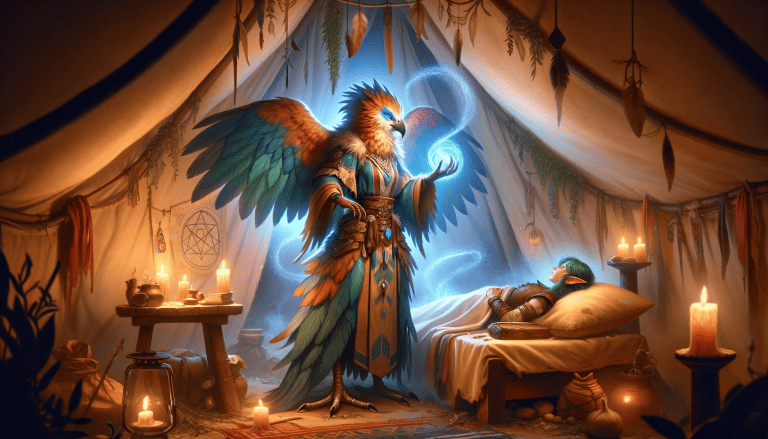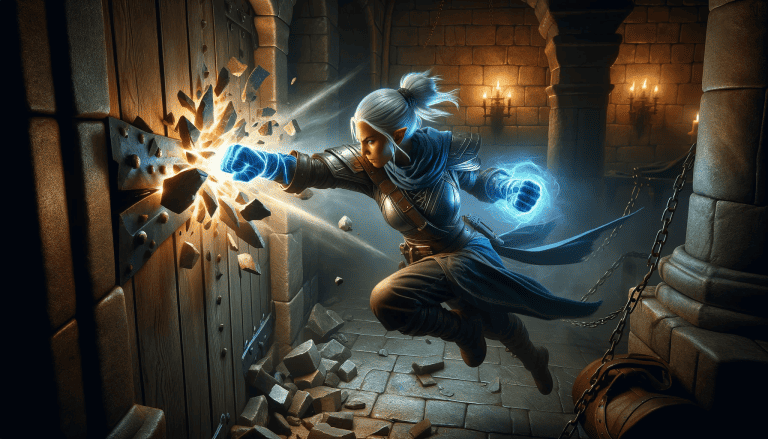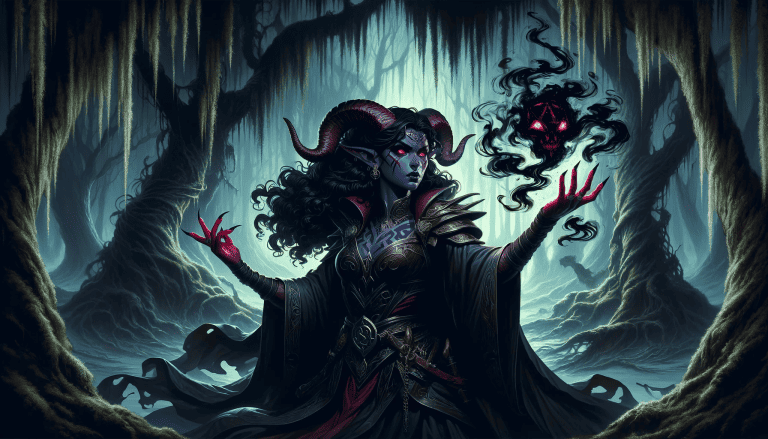How to Play Grave Domain Cleric in 5e D&D
Few adventurers are saddled with a responsibility like Grave Clerics are. It’s their duty to keep the natural cycle of birth and death, ensuring none live beyond their appointed lifespan while also saving chosen heroes from dying before their time. Whether your backstory leads you to try and forestall death or drives you to end unnatural undeath, you’ll be touched by the grave wherever you go.
Fluff aside, Grave Clerics make for some of the best support characters in the game, working double-time to keep their party alive and kicking. Toss in some insane damage potential, and you have a well-rounded build that will become an integral part of your party.
Grave Clerics dedicate themselves to one of many gods who guard the balance of life and death, such as Kelemvor, Lathander, Myrkul, Savras, or Sehanine Moonbow. If you’re looking to play a necromancer without being evil, Grave Cleric is the choice for you. Read on for tips on how to play this unique subclass!
Using This Guide
Everything in this guide has an emoji, ranking how useful a given ability or feature is to play a Cleric effectively.
✅ — An absolutely crucial feature. Often forms the backbone of a class’ look and feel. Will provide some bonus that can’t be found through other means.
🆗 — A solid feature that does its job well. Not game-breaking, and certainly replaceable, but a strong choice that shores up some weakness.
⚠️ — A debatable choice. Could work for a specific build, but otherwise is either a wasted opportunity or is just weaker than other alternatives.
⛔ — Outright bad and detrimental. This weighs down the class and just takes up space on the character sheet. A weakness you will have to accommodate for.
These rankings are meant to help you create an optimized class build but remember—DnD isn’t a game where you need to win to have fun. Weaker but flavorful builds also have their place and can make for fulfilling characters.
How to Play a Grave Cleric
Out of all the Cleric subclasses, the Grave Domain is best at keeping your party from dying. Your role is to hand out buffs like candy while your party is fighting, then when one of them is knocked unconscious, you swoop in to save them before they fail their last death save (Support). Just be wary—your own defenses aren’t great, so keeping yourself away from danger is the best way to support your party.
Hitting your optimization threshold as a Grave Cleric can be tricky because most of your best subclass features and spells work reactively. Your best bet is to assemble as many tricks as you can in your spellcasting toolbox, get your Wisdom to 20 as soon as possible, then play for a while to see what unexpected weaknesses arise.
Being an Effective Support
Most of the time, you should be running a buff spell that makes it more difficult for a party member to die. Another viable option is buffs that increase your party’s damage output so combat ends before anyone gets hurt.
When a party member does go down, heal them as soon as possible. If some pressing need forces you to cast some other spell on your turn, at least use spare the dying as a bonus action to stabilize them. To prevent your friends from getting knocked unconscious in the first place, keep healing them. Also, try to preempt damage with protective spells; it’s often more efficient than just healing up someone as they continuously get stabbed.
🛡️ Looking for another subclass? Check out our guide to Life Domain Cleric

Grave Domain Subclass Features
Your primary role as a Grave Cleric will be to keep your allies alive, either through healing, negating threats, or reviving them once they fall. The variety of your subclass features allow you to fill this role in several ways, though you’re always pushed towards helping reactively.
✅ Domain Spells
1st Level
🆗 Bane
A d4 penalty is nothing to scoff at, even against big monsters, but only use this if using a buff instead would be ineffective.
🆗 False Life
A solid HP bump at lower levels, but you’ll probably rely on it less at higher levels. No concentration makes this especially useful.
2nd Level
✅ Gentle Repose
Makes your resurrection spells much better since their power scales with how quickly you need to cast them. An excellent spell to have permanently prepared.
⚠️ Ray of Enfeeblement
Not a particularly powerful effect. Except against huge beasties like dragons.
3rd Level
✅ Revivify
Resurrection spells are crucial for a support class, and having this permanently prepared means the time limit is less limiting. A staple spell for Grave Cleric.
🆗 Vampiric Touch
A cost-efficient attack for a decent bit of damage. Nothing huge, but fairly reliable, and healing yourself should never be underestimated.
4th Level
✅ Blight
Powerful and scales well when cast with higher-level spell slots. A good go-to if you are backed into a corner and need to deal damage.
✅ Death Ward
An absolute must. Have it on at least one of your party members at all times. The 8-hour duration and the fact that it doesn’t require concentration make this spell essential.
5th Level
🆗 Antilife Shell
Very effective at staving off a wave of melee-attacking enemies. Can also be used to block off a corridor.
✅ Raise Dead
Other than revivify, this is the only resurrection spell that really benefits from being permanently prepared. More flexibility makes this a powerful tool.
🆗 Circle of Mortality
Extra healing for downed allies equals great value. But the real winner here is spare the dying as a bonus action with range. So much easier to stabilize a friend without having to sacrifice your turn.
⚠️ Eyes of the Grave
In an undead-heavy campaign (looking at you, Curse of Strahd), this is only occasionally useful. The rest of the time, it’s pretty weak. If you want this, multiclass as a Ranger with undead as your favored enemy.

✅ Channel Divinity: Path to the Grave
Setting up a double-damage hit is a superb way to spend your turn when you’re not healing or buffing someone. Combine this with a crit or a sneak attack and it gets insane.
✅ Sentinel at Death’s Door
A surprise critical can kill a friend before you get a chance to heal them. Negating that crit is, therefore, indispensable and leaves your ally in a better place to counterattack and be healed.
✅ Potent Spellcasting
You’re a spellcaster, so you will use cantrips to attack all the time. Excellent damage boost.
🆗 Keeper of Souls
This provides some passive healing, so your party is constantly getting topped up. Takes some of the pressure off of you and offers your party members a nice reward for hunting down the biggest threats.
🛡️ Not convinced yet? Try playing a Twilight Domain Cleric instead
The Perfect Grave Domain Build
Ability Scores
⛔ Strength
Dump stat.
🆗 Dexterity
You probably won’t use this for weapon attacks, but the AC bump is a welcome defensive bonus.
🆗 Constitution
Your party is really screwed if you drop, so extra health is essential to not dying. Also helps you maintain concentration on buff spells.
⛔ Intelligence
Dump stat.
✅ Wisdom
Your magic uses Wisdom, and you are a spellcaster before anything else. Keep this high so enemies can’t resist your effects and so you heal for extra health.
⛔ Charisma
Dump stat.
Races
✅ Protector Aasimar is one of if not the best race for Grave Cleric since their myriad of extra abilities gives you tons of flexibility as a support. Githzerai, Hill Dwarf, Lizardfolk, and Tortle are also quality options that improve your defenses to keep you alive and healing.
🆗 Variant Human with the war caster feat makes for a strong start. Firbolg, Reborn, and Warforged are decent defensive options. Otherwise, Water Genasi, Harengon, and Kalashtar are well-rounded picks.
Feats
✅ Heavily Armored
If you can meet the Strength requirement, this helps shore up your AC and lets you take more risks in combat.
✅ Lucky
You’re a little weak defensively, so making an attack miss you can be a lifesaver.
🆗 Medium Armor Master
Eeking out a little extra AC never hurts, and ditching the disadvantage on stealth makes higher AC medium armor more viable.
✅ Tough
You really don’t want to go down in battle. With limited AC, more HP is your best way to survive.
✅ War Caster
You want to be dropping buffs as much as possible, so improved concentration checks are a big help. Plus you can sneak in some serious damage with opportunity attacks.

Spells
Note: This section skips spells already gained through Domain Spells.
Cantrips
- 🆗 Guidance: A solid buff that you might as well be using all the time since it’s a cantrip.
- 🆗 Resistance: Same logic as guidance, but more useful in combat. A good default spell to concentrate on unless a better buff needs casting.
- ✅ Toll the Dead: You won’t attack as much as other subclasses, but when you do, this is your best option.
1st Level
- 🆗 Bless: Improves the attacks and saves of lots of allies. Excellent value and is potent even at higher levels.
- ✅ Cure Wounds: One of your best healing options. Essential to playing a good support role.
- ✅ Healing Word: Another indispensable healing option, but the range and bonus action casting time make this less of a go-to and more of a niche emergency spell.
- 🆗 Sanctuary: Good defensive spell to protect your squishiest party member (which might be you).
- ✅ Shield of Faith: A monster buff that never gets old. Provides such a huge advantage to your target that you should use it all the time.
2nd Level
- 🆗 Aid: The health boost is small, but it lasts all day and doesn’t require concentration.
- 🆗 Enhance Ability: A nice way to help your party outside of combat or improve your own stats.
- 🆗 Lesser Restoration: Good utility, though you often get a minor effect in exchange for an entire spell slot.
- ✅ Prayer of Healing: Nothing says value like group heals. This gives plenty of health and can turn the tide of a battle.
- ✅ Spiritual Weapon: Keeps you relevant in combat, even when you’re occupied playing support. A bonus action attack every turn adds up to a substantial amount of damage.
3rd Level
- 🆗 Aura of Vitality: Easy to squeeze a lot of health out of this before the spell ends. Very efficient and lets you spend your action on something other than healing.
- ✅ Beacon of Hope: Improves your healing spells, keeps your allies from dying, and makes them able to resist enemy spells better. Tons of handy effects in one package.
- 🆗 Magic Circle: Good to protect your whole party at once, and very hard for enemies to circumvent.
- ⚠️ Mass Healing Word: A flexible group heal that works best in a pinch, but otherwise doesn’t restore that much health.
- ⚠️ Remove Curse: Handy, but very situational.

4th Level
- 🆗 Aura of Life: Saves you from casting spare the dying on your turn. The other effects are neat but nothing incredible.
- 🆗 Aura of Purity: A more efficient way to cure conditions than lesser restoration.
- 🆗 Guardian of Faith: Deals loads of damage, and if placed right, can be a very effective obstacle.
5th Level
- 🆗 Greater Restoration: Better than its lesser variant because this cures very niche effects that you can’t just wait to dissipate naturally. Necessary utility for your party.
- ✅ Holy Weapon: Probably the best buff you can grant. This is an insane power boost for your target, and lasts a long time too.
- ✅ Mass Cure Wounds: Good range, good healing, lots of targets—this is a staple support spell for good reason.
6th Level
- ⚠️ Harm: Good in one circumstance—if you use the War Caster feat to cast a spell as your opportunity attack, this has a good chance of instantly annihilating a monster that was getting up in your face.
- ✅ Heal: Having a static value for HP restored makes for a more reliable spell. And the value is nothing to scoff at either.
7th Level
- 🆗 Divine Word: A great way to clear a crowd of weakened enemies, preventing your party from getting overwhelmed.
- ✅ Regenerate: With enough time, this can be a full heal. Perfect for patching someone up while mid-travel.
- ✅ Resurrection: Your best option if you miss the window on your cheaper resurrection spells. Restoring missing limbs is also solid.
8th Level
- 🆗 Antimagic Field: Your subclass features don’t do much against spell damage and instant kills. This is a perfect countermeasure for those, stopping the threat before it can even touch your allies.
- ✅ Holy Aura: This is stupid good. Empowers your whole party while weakening a ton of enemies. A very strong buff for high-level encounters like boss fights.
9th Level
- ✅ Mass Heal: You’ll be able to fully heal at least a couple allies with this. Or heal everyone just enough to get them back in the fight. Flexible and powerful.
- 🆗 Power Word: Heal: Best when you are both healing and curing a condition. Otherwise, mass heal is strictly better.
- ✅ True Resurrection: You won’t be using this for dead party members, but there’s nothing else in the game that solves the kind of problems this spell solves. And your party will look to you to cast it.

Equipment
You’re stuck with just medium armor, of which half plate is the best, so also grab a shield for extra AC. With simple weapon proficiency, greatclubs, handaxes, javelins, maces, quarterstaffs, and spears are best for melee damage. A light crossbow is your strongest ranged weapon.
Until Next Time
Like the other subclasses from the book “Xanathar’s Guide to Everything,” Grave Cleric brings fun new twists and a nice power spike. Did you find this guide helpful? Then share it with your friends, and tell us your thoughts in the comments below.







